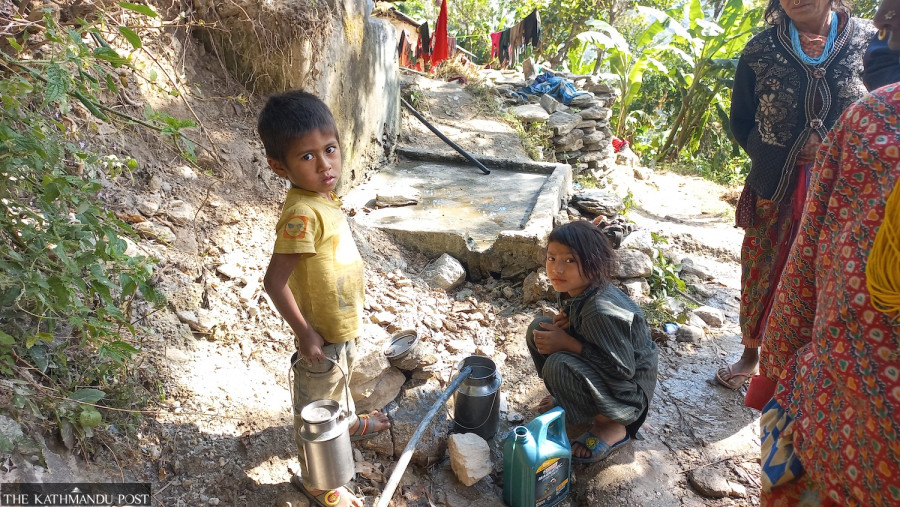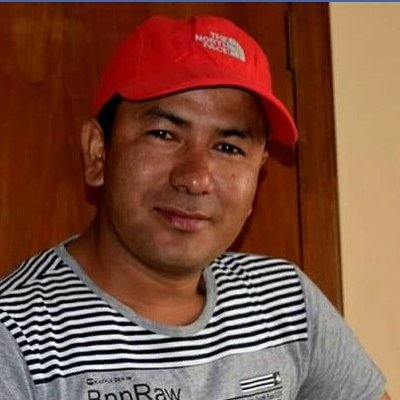Sudurpaschim Province
October floods and landslides disrupt water supply in Bajhang
Around 20,000 families are left without safe drinking water, which could lead to outbreak of diseases.
Basant Pratap Singh
Around 20,000 families in Bajhang have been facing a shortage of drinking water since the third week of October, when floods and landslides set off by heavy rainfall disrupted the supply of drinking water to the district.
Kali Kami of Masuradi village in Khaptad Chhanna Rural Municipality-1 and her family were displaced by the October landslides. Kali and her four children are currently taking shelter at a neighbour’s house.
She says her family has a limited provision of food and clothes but what they need right now is clean drinking water, as multiple landslides have completely destroyed a drinking water project that supplied water to the entire village.
“There was only one drinking water project in the village. With it destroyed, there is no source of clean drinking water nearby,” said Kali.
All 22 families in Masuradi belong to freed Haliyas (ploughmen) and none of them has access to clean drinking water. The villagers have to rely on unsafe water from rivers and rivulets to meet their water needs.
“We get water from a local stream around two kilometres from the settlement,” said Kali.
Health workers in the villages are concerned that the inaccessibility to clean drinking water could lead to an outbreak of water-borne diseases.
“The number of patients suffering from various water-borne diseases has increased significantly since the October landslides and floods that damaged many drinking water projects. The health post receives around 40 to 50 patients of typhoid, diarrhoea and dysentery on a daily basis,” said Dhirendra Khadka, an auxiliary health worker at Kailash Health Post in Jayaprithvi Municipality.
Puskal Singh, his wife and their two children aged five and eight suffered from diarrhoea last week after drinking floodwaters from the local rivulet in light of the water crisis in the village.
“There is no clean drinking water supply in the village. We are compelled to use murky water from the local rivulet for cleaning, cooking, washing and even drinking,” said Singh. “But the whole family suffered from severe diarrhoea so we went to the local health post for treatment. The health workers said we were falling sick because of unsafe water.”
The rise in the number of patients with water-borne diseases has depleted the stock of essential medicines at the health post, says Khadka.
To avoid a health emergency in the villages, health workers have advised people to boil and treat water from unsafe sources before consumption.
“We ask the locals affected by the water shortage to take precautions and not drink unsafe water without treating it first,” said Debendra Kathayat, a doctor at the Bajhang District Hospital. “The government should provide water treatment chemicals to the affected people immediately. If immediate action is not taken, villages in Bajhang will face a health crisis.”
According to Ain Bahadur Rokaya, the information officer of Khaptad Chhanna Rural Municipality, a total of 66 drinking water projects in the local unit were damaged by October’s floods and landslides.
“Almost all drinking water projects in the local unit were damaged by the disasters. Several villages are reeling under an acute shortage of drinking water and have turned to using water from rivers and streams,” said Rokaya. “Over 1,000 people in Khaptad Chhanna Rural Municipality alone do not have access to clean drinking water anymore.”
The shortage of water is a new challenge for the local people of Pimi in Jayaprithvi Municipality-1. Around 200 households are now compelled to drink murky water from a local stream after the October landslides caused damage to the Bhera Drinking Water Project and Gauda Drinking Water Project.
Drinking water supply has been disrupted in almost all settlements of 11 local units, except Saipal Rural Municipality, in the district.
“The sources of some drinking water projects were swept away while the landslides and floods damaged reservoirs and pipelines of others. The drinking water supply system is almost nonexistent in the local unit now,” said Chhatra Joshi, the water resource officer of Thalara Rural Municipality. According to him, the recent floods and landslides damaged around 50 drinking water projects in Thalara. “More than 2,500 households in the local unit are drinking murky water from local streams, wells and irrigation canals.”
Nisha Thagunna, the vice-chairperson of Kedarsyun Rural Municipality, says villagers in her local unit too have started to take ill from consuming water from rivers and streams after the October disaster.
“The villagers are falling ill after drinking unsafe water,” said Thagunna. “We are making efforts to repair the damaged water projects to avoid a health crisis.”
According to the initial estimate, around 20,000 households in Bajhang are facing a shortage of drinking water at present. However, the concerned authorities are yet to assess the total damage caused by the October disasters.
“We were informed that many drinking water projects were damaged in the disasters but detailed reports are yet to come,” said Bhakta Bahadur Khadka, the chief at Bajhang field office of the Drinking Water and Sanitation Division Office in Dadeldhura.
According to Chief District Officer Mohan Adhikari, who is also the chairman of the district natural disaster management committee, even after three weeks of the disasters, the extent of damage caused to drinking water projects is yet to be known because of the negligence of the division office.
“According to the information received from the local units, more than 20,000 households are facing an acute shortage of drinking water after the floods and landslides but the division office has yet to prepare the final report to gauge the extent of damage caused to drinking water projects,” said Adhikari.
The October floods and landslides in Bajhang killed 12 people while 19 others went missing in several parts of the district, according to the District Police Office in Bajhang.




 15.24°C Kathmandu
15.24°C Kathmandu













